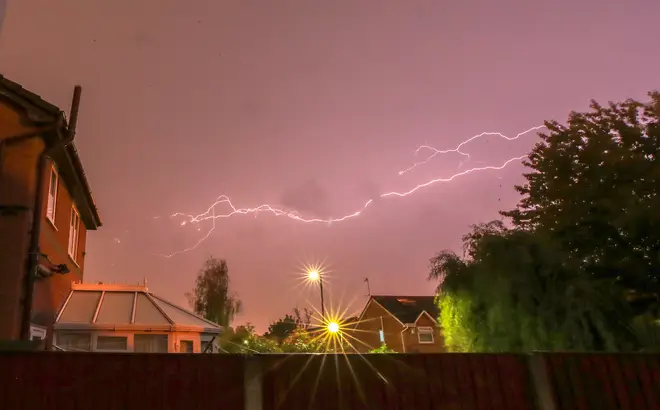
Clare Foges 6pm - 9pm
14 August 2020, 11:53

Thunderstorms have lit up the UK this week with forecasters issuing 'danger to life' warnings for large parts of the country, but what are thunderstorms? And why do they happen after a heatwave?
Thunderstorm warnings are in place for most of England and all of Wales after heavy rain and flash flooding brought disruption to roads and railways across the week.
And there are more warnings for the coming days with the Met Office issuing yellow thunderstorm warnings until Monday, with the potential for flooding and damage to buildings from lightning and hail.
Here are some interesting thunderstorm facts.
A thunderstorm is a series of sudden electrical discharges resulting from atmospheric conditions. These discharges result in sudden flashes of light and trembling sound waves, commonly known as thunder and lightning.
Thunder and lightning are associated with convective clouds and are often accompanied by heavy rain or hail.
Thunder is the sound produced by the rapid heating of air by a lightning strike, and lightning is a huge electrical discharge that flows between clouds, from a cloud to air, or from a cloud to the ground.

Lightning captured inside Taal volcano eruption
The two vital ingredients for a thunderstorm are instability in the atmosphere and moisture.
Thunderstorms take place when there is more humid air in the system, which is the case at the moment during the ongoing heatwave.
They tend to develop later in the afternoon after the progressive heating during the early part of the day.
Thunderstorms are created by the intense heating of the earth's surface and are most common in parts of the world where the weather is hot and humid.
The Met Office says thunderstorms develop when the atmosphere is unstable - when warm air exists underneath much colder air.

House set on fire after being hit by lightning
Thunderstorms are common occurrences on Earth.
It is estimated that a lightning strike hits somewhere on the Earth's surface approximately 44 times every second, a total of nearly 1.4 billion lightning strikes every year.
In the UK, thunderstorms are most common over the East Midlands and the south east of England.
There are several different types, according to the Met Office.
Ball lightning - a rare form of lightning in which a persistent and moving luminous white or coloured sphere is seen.
Rocket lightning - a very rare and unexplained form of lightning in which the speed of propagation of the lightning stroke is slow enough to be perceptible to the eye.
Pearl-necklace lightning - a rare form of lightning in which variations of brightness along the discharge path give rise to a momentary appearance similar to pearls on a string.
Ribbon lightning - ordinary cloud-to-ground lightning that appears to be spread horizontally into a ribbon of parallel luminous streaks when a very strong wind is blowing at right angles to the observer's line of sight.
Forked lightning - lightning in which many luminous branches from the main discharge channel are visible.
Sheet lightning - the popular name applied to a "cloud discharge" form of lightning in which the emitted light appears diffuse and there is an apparent absence of a main channel because of the obscuring effect of the cloud.
Streak lightning - a lightning discharge which has a distinct main channel, often tortuous and branching, the discharge may be from cloud to ground or from cloud to air.